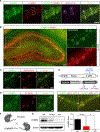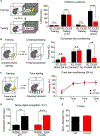Gating of hippocampal rhythms and memory by synaptic plasticity in inhibitory interneurons
- PMID: 33548174
- PMCID: PMC9239733
- DOI: 10.1016/j.neuron.2021.01.014
Gating of hippocampal rhythms and memory by synaptic plasticity in inhibitory interneurons
Abstract
Mental experiences can become long-term memories if the hippocampal activity patterns that encode them are broadcast during network oscillations. The activity of inhibitory neurons is essential for generating these neural oscillations, but molecular control of this dynamic process during learning remains unknown. Here, we show that hippocampal oscillatory strength positively correlates with excitatory monosynaptic drive onto inhibitory neurons (E→I) in freely behaving mice. To establish a causal relationship between them, we identified γCaMKII as the long-sought mediator of long-term potentiation for E→I synapses (LTPE→I), which enabled the genetic manipulation of experience-dependent E→I synaptic input/plasticity. Deleting γCaMKII in parvalbumin interneurons selectively eliminated LTPE→I and disrupted experience-driven strengthening in theta and gamma rhythmicity. Behaviorally, this manipulation impaired long-term memory, for which the kinase activity of γCaMKII was required. Taken together, our data suggest that E→I synaptic plasticity, exemplified by LTPE→I, plays a gatekeeping role in tuning experience-dependent brain rhythms and mnemonic function.
Keywords: CaMKII; LTP; inhibitory interneurons; learning and memory; network oscillations; network plasticity; synaptic plasticity.
Copyright © 2021 Elsevier Inc. All rights reserved.
Conflict of interest statement
Declaration of interests H.H. and S.D. are members of advisory boards for the journal Neuron.
Figures







Similar articles
-
A Critical Role for γCaMKII in Decoding NMDA Signaling to Regulate AMPA Receptors in Putative Inhibitory Interneurons.Neurosci Bull. 2022 Aug;38(8):916-926. doi: 10.1007/s12264-022-00840-x. Epub 2022 Mar 15. Neurosci Bull. 2022. PMID: 35290589 Free PMC article.
-
Rational designing of oscillatory rhythmicity for memory rescue in plasticity-impaired learning networks.Cell Rep. 2022 Apr 12;39(2):110678. doi: 10.1016/j.celrep.2022.110678. Cell Rep. 2022. PMID: 35417714
-
Regulation of Hippocampal Memory by mTORC1 in Somatostatin Interneurons.J Neurosci. 2019 Oct 23;39(43):8439-8456. doi: 10.1523/JNEUROSCI.0728-19.2019. Epub 2019 Sep 13. J Neurosci. 2019. PMID: 31519824 Free PMC article.
-
A fresh look at the role of CaMKII in hippocampal synaptic plasticity and memory.Bioessays. 2002 Mar;24(3):223-33. doi: 10.1002/bies.10057. Bioessays. 2002. PMID: 11891759 Review.
-
Glutamatergic synapses onto hippocampal interneurons: precision timing without lasting plasticity.Trends Neurosci. 1999 May;22(5):228-35. doi: 10.1016/s0166-2236(98)01347-2. Trends Neurosci. 1999. PMID: 10322496 Review.
Cited by
-
Paradoxical self-sustained dynamics emerge from orchestrated excitatory and inhibitory homeostatic plasticity rules.Proc Natl Acad Sci U S A. 2022 Oct 25;119(43):e2200621119. doi: 10.1073/pnas.2200621119. Epub 2022 Oct 17. Proc Natl Acad Sci U S A. 2022. PMID: 36251988 Free PMC article.
-
Hippocampal parvalbumin interneurons play a critical role in memory development.Cell Rep. 2022 Nov 15;41(7):111643. doi: 10.1016/j.celrep.2022.111643. Cell Rep. 2022. PMID: 36384113 Free PMC article.
-
CaMKIIα Promoter-Controlled Circuit Manipulations Target Both Pyramidal Cells and Inhibitory Interneurons in Cortical Networks.eNeuro. 2023 Apr 10;10(4):ENEURO.0070-23.2023. doi: 10.1523/ENEURO.0070-23.2023. Print 2023 Apr. eNeuro. 2023. PMID: 36963833 Free PMC article.
-
The Engram's Dark Horse: How Interneurons Regulate State-Dependent Memory Processing and Plasticity.Front Neural Circuits. 2021 Sep 13;15:750541. doi: 10.3389/fncir.2021.750541. eCollection 2021. Front Neural Circuits. 2021. PMID: 34588960 Free PMC article. Review.
-
Deciphering the Role of Shank3 in Dendritic Morphology and Synaptic Function Across Postnatal Developmental Stages in the Shank3B KO Mouse.Neurosci Bull. 2025 Apr;41(4):583-599. doi: 10.1007/s12264-024-01330-y. Epub 2024 Dec 18. Neurosci Bull. 2025. PMID: 39693031 Free PMC article.
References
-
- Allen K, and Monyer H. (2015). Interneuron control of hippocampal oscillations. Curr. Opin. Neurobiol. 31, 81–87. - PubMed
-
- Bartos M, Vida I, and Jonas P. (2007). Synaptic mechanisms of synchronized gamma oscillations in inhibitory interneuron networks. Nat. Rev. Neurosci. 8, 45–56. - PubMed
-
- Bliss TV, and Collingridge GL (1993). A synaptic model of memory: long-term potentiation in the hippocampus. Nature 361, 31–39. - PubMed
Publication types
MeSH terms
Substances
Grants and funding
LinkOut - more resources
Full Text Sources
Other Literature Sources
Molecular Biology Databases

